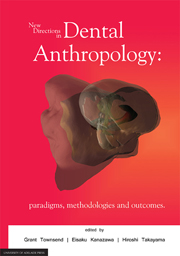Book contents
- Frontmatter
- Foreword
- Contents
- 1 Modelling the complexity of the dentition
- 2 New approaches to dental anthropology based on the study of twins
- 3 Genes for teeth — drawing inference from family data
- 4 Do feeding practices, gestation length, and birth weight affect the timing of emergence of the first primary tooth?
- 5 Sexual dimorphism in the primary and permanent dentitions of twins: an approach to clarifying the role of hormonal factors
- 6 Dental crown and arch size in Europeans and Australian Aboriginals
- 7 Sex determination from maxillary and mandibular canines of the Filipino population
- 8 Non-metric dental characteristics in Papua New Guinea Highlanders and their association with molar reduction
- 9 The Main Occluding Area between opposing teeth during chewing: a comparison between Australians and Japanese
- 10 “Mineral Maintenance” of dental structures in caries and erosive tooth wear: an holistic model
- 11 Emerging techniques for the analysis of tooth wear
10 - “Mineral Maintenance” of dental structures in caries and erosive tooth wear: an holistic model
Published online by Cambridge University Press: 05 May 2013
- Frontmatter
- Foreword
- Contents
- 1 Modelling the complexity of the dentition
- 2 New approaches to dental anthropology based on the study of twins
- 3 Genes for teeth — drawing inference from family data
- 4 Do feeding practices, gestation length, and birth weight affect the timing of emergence of the first primary tooth?
- 5 Sexual dimorphism in the primary and permanent dentitions of twins: an approach to clarifying the role of hormonal factors
- 6 Dental crown and arch size in Europeans and Australian Aboriginals
- 7 Sex determination from maxillary and mandibular canines of the Filipino population
- 8 Non-metric dental characteristics in Papua New Guinea Highlanders and their association with molar reduction
- 9 The Main Occluding Area between opposing teeth during chewing: a comparison between Australians and Japanese
- 10 “Mineral Maintenance” of dental structures in caries and erosive tooth wear: an holistic model
- 11 Emerging techniques for the analysis of tooth wear
Summary
ABSTRACT
It is argued that dental structures within the oral environment have evolved with an ability to resist dissolution when exposed to acidic conditions, and to promote remineralisation after damage has occurred. It is hypothesised that dietary acids acted as one of the selective forces in the evolution of the oral environment. It appears that a balance was achieved in hunter-gatherer populations, with the composition and action of saliva, and associated oral biofilms, evolving to protect the teeth against dietary acids. However, in the relatively short period of time since the development of farming and especially with the adoption of modern cultural practices, changes in diet have overwhelmed the oral environment, creating an imbalance. In general, the vast increase in consumption of acidic foods and drinks has decreased the protective mechanisms of saliva. Similarly, the increased consumption of sugar has changed the ecology of oral biofilms, leading to and maintaining a lower oral pH. A combination of these factors has tipped the balance towards demineralisation and increased the risk of oral diseases, such as dental caries and erosive wear, that are so prevalent in many of today's societies.
INTRODUCTION
The Paleolithic, stone age or hunter-gatherer way of life, covers a period of over 2.5 million years of hominin evolution, culminating with the appearance of modern Homo sapiens over 200,000 years ago. This period demonstrates the most basic technological developments including the use of the most primitive stone tools (Toth and Schick, 2007).
- Type
- Chapter
- Information
- New Directions in Dental AnthropologyParadigms, Methodologies and Outcomes, pp. 115 - 122Publisher: The University of Adelaide PressPrint publication year: 2012
- 1
- Cited by



